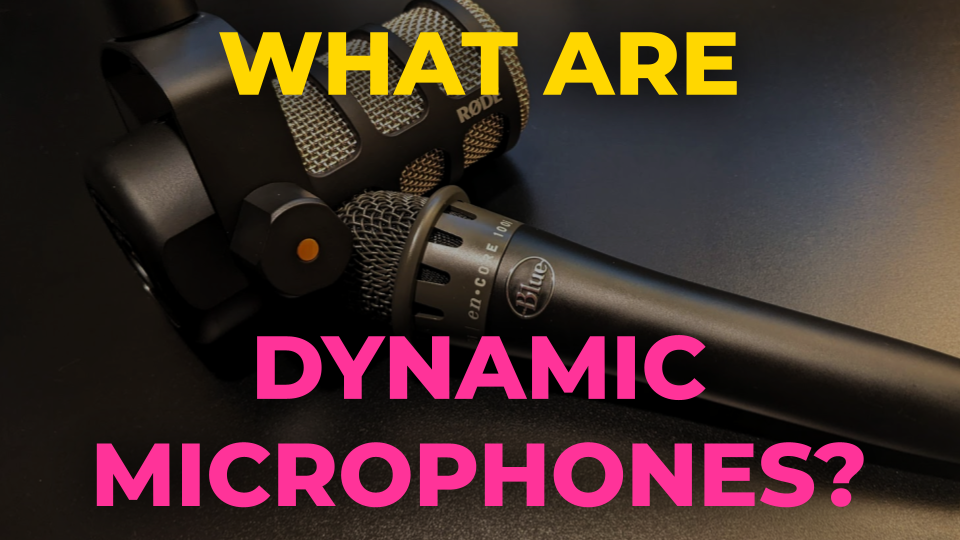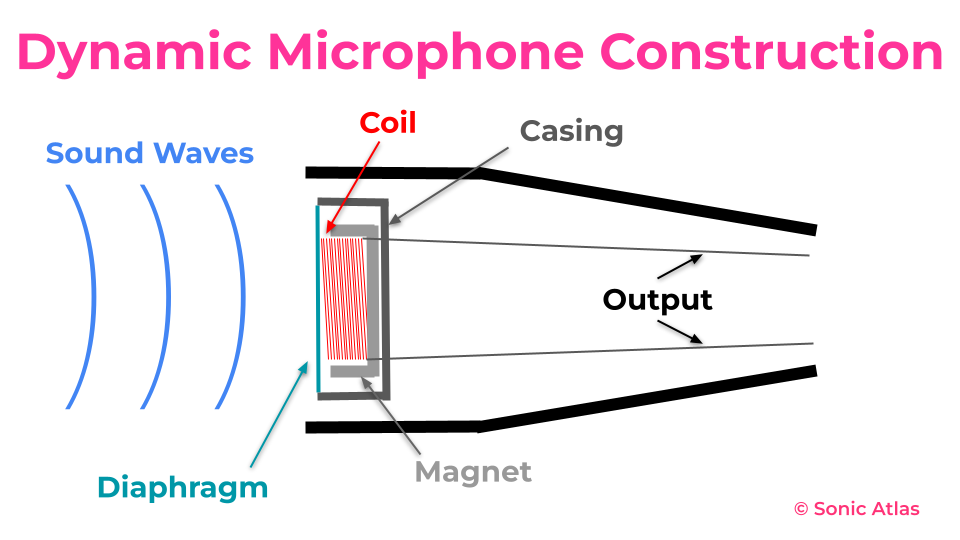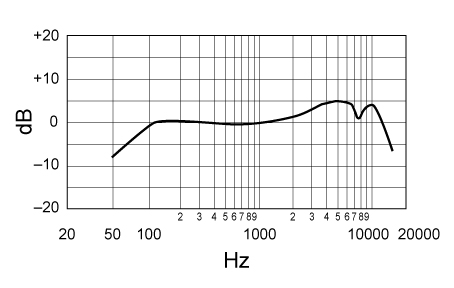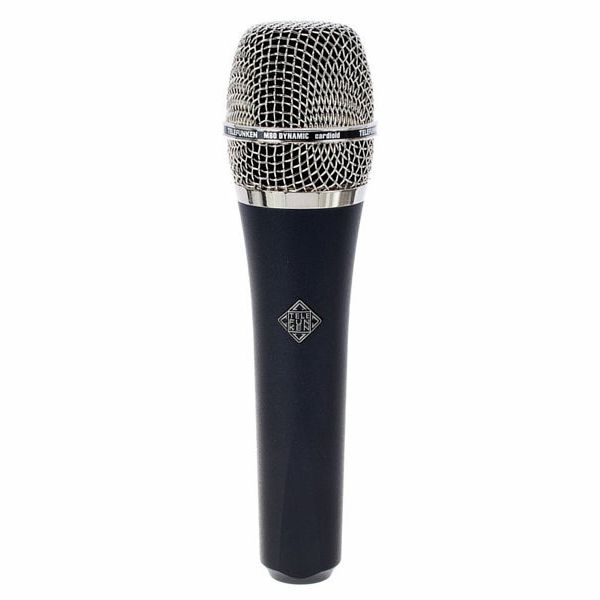You can categorize microphones into one of two major groups: Dynamic Microphones, and Condenser Microphones.
Dynamic microphones are incredibly common, and people use them for everything. But what makes them “dynamic” microphones, anyway? And how exactly do they work?

What is a Dynamic Microphone?
A dynamic microphone is a type of mic that uses electromagnetism to convert sound waves into electrical signals. It’s a simple, rugged, and affordable type of microphone that’s well-suited for various applications, including live sound, recording, and broadcasting.
How Dynamic Microphones Work
There are three main parts of a dynamic microphone:
- Diaphragm: The thin membrane that vibrates when hit by sound waves.
- Coil: Usually made of copper. The coil connects to the diaphragm and vibrates with it.
- Magnet: Creates an electromagnetic field around the coil and transmits the electrical signal.
Sound waves hit the dynamic mic’s diaphragm, causing it to vibrate. This causes the coil to also vibrate within the magnet, creating an electrical current. Finally, the current gets transmitted as an audio signal to another device like an audio interface, mixer, or loudspeaker.
This process is known as electromagnetic induction.

Major Types of Dynamic Microphones
There are two major types of dynamic microphones: Moving Coil microphones and Ribbon Microphones.
Type 1: Moving Coil Dynamic Microphones
The term “dynamic microphone” almost always refers to moving coil microphones. They’re the most common type of dynamic microphone.
As explained above, they use a metal coil and magnet to create an electric signal.
Since both the diaphragm and coil vibrate, the parts are relatively heavy. Due to the weight, they can’t respond quickly enough to higher frequencies. And as a result, the microphone’s frequency response falls off above 10 kHz.
In other words, moving coil mics don’t capture high-pitched sounds as well as ribbon and condenser mics.
That said, they often have a natural presence boost somewhere around 1–5 kHz. This makes them perfect for vocalists who want to sound more intelligible.
You can see these tendencies in this Shure SM58 response graph.

Type 2: Ribbon Microphones
Note: Even though they’re technically dynamic microphones, ribbon mics are different enough to be considered their own major category. In the practical world, you’ll never hear anyone call them “dynamic mics”.
Ribbon mics are prized for their warm, detailed sound. They’re less common than moving coil microphones, but they operate using the same principles.
The biggest difference is that they use a thin strip of aluminum foil (or “ribbon”) instead of a coil and diaphragm. The ribbon is light enough to be vibrated directly, so no diaphragm is needed.
However, the electrical signal generated is very small compared to moving-coil mics. So most ribbon mics also have an output transformer to help boost the signal.

While they sound incredible, ribbon microphones are not beginner-friendly.
In general, they’re more fragile and have highly sensitive components. The ribbon can also get damaged if you use 48-volt phantom power.
As a result, they’re generally more expensive and require extensive care while operating.
Professional recording studios often have them. But I usually recommend average consumers stay away from them.
Common Applications for Dynamic Microphones
Dynamic microphones are workhorses with a wide range of applications. You can use them in virtually any situation and get good results.
Vocals (Studio Recording & Broadcasting)
For most singers, a dynamic microphone is the way to go. They can handle loud vocals and screaming lyrics without any major issues.
Dynamics are also the go-to mics for broadcasting. The Shure SM7B has long been a golden standard for radio stations, and it’s still a favorite among YouTubers, streamers, and podcasters.
Other great examples include the Shure MV7 and the Rode PodMic.
The industry-standard broadcast microphone. This celebrated mic is the go-to for countless singers, voice-over artists, podcasters, YouTubers, and everyone in between.
A broadcast-quality mic for podcasters and streamers on a budget. With an integrated pop filter, it'll deliver silky-smooth vocals every time.
Vocals (Live Performance)
Dynamic microphones are particularly great for isolating sounds in a noisy environment. It’s why you’ll want to use them for live shows.
The Shure SM58 is the industry standard for live vocals. The Sennheiser e835 and Behringer XM8500 are also great SM58 alternatives.
The Shure SM58 is the gold standard among handheld dynamic microphones. It's great for vocals and useful for just about everything.
The e835 is a fantastic alternative to other popular handheld vocal mics. Its high-quality design reduces hum and handling noise, so you'll get crisp, clear audio every time.
A budget-friendly dynamic microphone that works as well as top-brand mics. The XM8500 is a great replacement or backup for your existing mics.
Loud Instruments & Sound Sources
Dynamic mics can also handle high sound pressure levels (SPLs) like a champ! This makes them ideal for close-miking loud sound sources:
- Drum Kits — It’s not uncommon to see a dynamic microphone on each individual snare, tom, and kick drum. You can play around with the mic positioning of each drum to capture different sounds and colors.
- Amplifiers — Dynamic mics are usually the microphone of choice for capturing sound from guitar, bass, and keyboard amps.
- Brass Instruments — These often includes trumpets, trombones, tubas, or saxophones. Brass instruments are loud and directional, which make dynamic mics the best for the job.
The most common instrument mic you’ll see is the Shure SM57. It’s like the Swiss Army Knife of microphones.
Other great instrument mics include the Audix i5 and Telefunken M80.
This battle-tested microphone is perfect for capturing just about everything. Use it to record vocals, guitars, drums, horns, and anything else you can think of.
The i5 is an exceptional instrument mic that challenges other industry standard mics. It offers a crisp high end while taming the harsh mid range. Use it to bring sounds to the front of your mix.
The M80 lets you produce clean, crisp-sounding audio from any source. Its narrow pickup pattern also helps you better isolate a signal.
Advantages & Disadvantages of Dynamic Microphones
Dynamic microphones are incredibly useful. That said, they have some shortcomings to consider.
Dynamic Mic Advantages
Robust and durable — These mics are generally really sturdy. You can drop them multiple times and they’ll work just the same.
High sound pressure level handling — Dynamics are the microphone of choice for recording loud sources like guitar amps, drums, brass, and screaming vocalists.
Low sensitivity for rejecting background noise — Dynamic mics require high input gain to work properly. As such, they’re perfect for isolating sounds on a noisy stage or in a crowded studio. They also do a good job rejecting room echo or background noises in an untreated room.
Relatively inexpensive — Generally speaking, dynamic mics have a simple construction that’s cheap to build. As such, you can pick up several good-to-great ones at a fairly low price.
No external power needed — You don’t need to turn on phantom power to operate these mics. Even if you did, it wouldn’t damage them.
Insensitive to humidity and environmental changes — The rigid and robust design of dynamic microphones makes them resistant humidity.
Dynamic Mic Disadvantages
Resonant peak — The natural resonance boost can negatively affect your recordings, especially if you want a more warm and resonant sound. For example, the Shure SM57 tends to give an extra “bite” or “edge” to a recording, while other mics offer a smoother balance across all frequencies.
High-frequency cutoff — Most dynamic mics have a roll-off after 10 kHz. As such, you can’t accurately record higher-frequency sounds.
Dynamic vs. Condenser Microphones
Without going into details, condenser microphones have a natural sound with a wider frequency response. That said, they’re super sensitive and tend to capture all room noise.
In other words, your big empty room will sound like a big empty room on a condenser mic. And that motorcycle driving by your house? You’ll hear that too.
Dynamic microphones have a narrower frequency range, but are generally better at rejecting room noise. They’re also better for close-miking loud sound sources.
Which is Better? Dynamic or Condenser Microphones?
If you’re new to audio production and don’t have any sound treatment in your room, I’d say go with a dynamic microphone. Otherwise, your recordings will sound like you’re in a high school gym.
If you have proper sound treatment and need to record higher-frequency sounds, go with a condenser microphone.
Know Your Microphone Polar Patterns
Now that you understand what a dynamic mic is and how it works, you should understand the polar patterns they come with.
For a detailed explanation of each, check out our Microphone Polar Pattern Guide.








